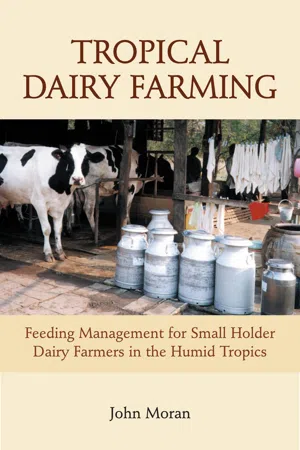
Tropical Dairy Farming
Feeding Management for Small Holder Dairy Farmers in the Humid Tropics
- 312 pages
- English
- ePUB (mobile friendly)
- Available on iOS & Android
Tropical Dairy Farming
Feeding Management for Small Holder Dairy Farmers in the Humid Tropics
About this book
Tropical Dairy Farming is a manual designed for use by dairy production advisors working in tropical areas, especially in South-East Asia. It aims to increase the productivity of small holder dairy farmers in the humid tropics by improving the feeding management of their livestock. It shows how to provide dairy cows with cost-effective feeds that match small holder farming systems and discusses the major obstacles to improving feeding management in the humid tropics.
The author shows the benefits and drawbacks of various feed components and the calculation of balanced diets based mainly on forages combined with some supplementary feeding. Diseases and problems associated with unbalanced diets are also covered, as well as important information on growing and conserving quality forages as silage.
The book draws on examples from a variety of countries including Indonesia, Malaysia, Thailand, Vietnam, China, East Timor and the Philippines.
Frequently asked questions
- Essential is ideal for learners and professionals who enjoy exploring a wide range of subjects. Access the Essential Library with 800,000+ trusted titles and best-sellers across business, personal growth, and the humanities. Includes unlimited reading time and Standard Read Aloud voice.
- Complete: Perfect for advanced learners and researchers needing full, unrestricted access. Unlock 1.4M+ books across hundreds of subjects, including academic and specialized titles. The Complete Plan also includes advanced features like Premium Read Aloud and Research Assistant.
Please note we cannot support devices running on iOS 13 and Android 7 or earlier. Learn more about using the app.
Information
1
Introduction
1.1 The feeding manual
1.1.1 Aims of the manual
- understand the nutritional requirements of cows and be able to express them in terms of dry matter, energy, protein and fibre
- compare feeds on the basis of their nutritive value
- understand the effect of nutrition on milk production, health and reproduction, and the growth of young dairy stock
- check whether a diet is balanced in terms of energy, protein and fibre
- understand how forages and feed supplements interact, including the factors that affect responses to supplements and how they determine the profitability of supplementary feeding
- calculate milk income less feed costs as a measure of profit
- understand the principles of growing quality forages
- understand the principles of making quality silage.
1.1.2 Outline of the manual
1.1.3 Sources of information
- Chapters 4, 5 and 6 (principles of the feeding management) were developed in Victoria during the late 1990s (Target 10 1999)
- Chapter 8 (growing forages) and Chapter 9 (silage making) were prepared for small holder farmer training programs in Indonesia (Moran 2001a, Mickan 2003)
- Chapter 15 (nutrition and fertility) was adapted from an Australian nationwide extension program ‘InCalf’ (Morton et al. 2003)
- Chapter 16 (nutrition and young stock) was adapted from my books on the calf and heifer management (Moran and McLean 2001, Moran 2002)
- Chapter 18 (body condition scoring) was developed by a team of Victorian dairy scientists (Robins et al. 2003).
Table of contents
- Cover
- Title
- Copyright
- Foreword
- About the Author
- Acknowledgements
- Chemical warning
- Contents
- 1. Introduction
- 2 Tropical dairy systems
- 3. Small holder dairying
- 4. What is in feeds?
- 5. How the rumen works
- 6. Nutrient requirements of dairy cows
- 7. How feed requirements change during lactation
- 8. Growing quality forages
- 9. Making quality silage
- 10. Supplements for milking cows
- 11. Milk responses to supplements
- 12. Formulating a diet
- 13. Problems with unbalanced diets
- 14. Diet and milk production
- 15. Nutrition and fertility
- 16. Nutrition and young stock
- 17. Economics of feeding dairy cows
- 18. Body condition scoring
- 19. Overcoming environmental constraints to cow performance
- 20. Future developments in feeding management in the humid tropics
- References and further reading
- Glossary and abbreviations
- Appendix 1 Temperature Humidity Index
- Appendix 2 Conversion of units of measurements
- Appendix 3 Currency converter for South-East Asia
- Appendix 4 Vitamins and minerals required by dairy cows
- Appendix 5 Tables of nutrient requirements
- Appendix 6 Exercises from the manual
- Index